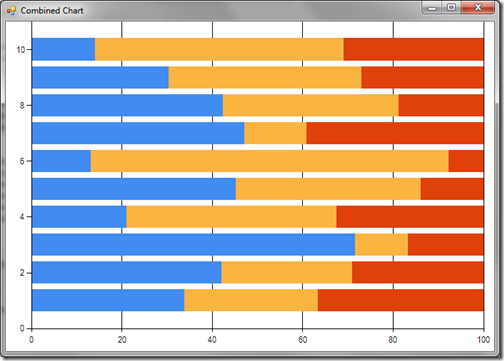Note
Access to this page requires authorization. You can try signing in or changing directories.
Access to this page requires authorization. You can try changing directories.
FSharpChart now supports binding for Stacked Charts and for modifying the Marker associated with a series.
As always one can download the latest release from:
https://code.msdn.microsoft.com/FSharpChart-b59073f5
In previous versions of FSharpChart it was not very intuitive how a Stacked Chart could be plotted. What one had to do was define a CombinedChart where one defines the charts to be combined with the same StackedGroupName property value:
let rndStacked = new System.Random()
let dataX() = [ for f in 1 .. 10 -> rndStacked.NextDouble() * 10.0]
FSharpChart.Combine
[ FSharpChart.StackedBar100(dataX(), StackedGroupName = "g1")
FSharpChart.StackedBar100(dataX(), StackedGroupName = "g1")
FSharpChart.StackedBar100(dataX(), StackedGroupName = "g1") ]
This displays the following chart:
(Thanks to Tomas Petricek for this sample)
This approach also allows one to easily combine multiple Stacked Charts using different StackedGroupName properties:
FSharpChart.Combine
[ FSharpChart.StackedBar(dataX(), StackedGroupName = "g1")
FSharpChart.StackedBar(dataX(), StackedGroupName = "g1")
FSharpChart.StackedBar(dataX(), StackedGroupName = "g1")
FSharpChart.StackedBar(dataX(), StackedGroupName = "g2")
FSharpChart.StackedBar(dataX(), StackedGroupName = "g2") ]
This displays the following chart:
However, for Stacked Charts, a more intuitive approach would be just to specify a list of data series. With this new release one can now specify the data series using the following formats:
list<list<'TY>>
list<list<'TX * 'TY>>
This now allows one to define, say a StackedColumn chart, using the much simpler expression:
let rndStacked = new System.Random()
let dataXY() = [ for f in 1 .. 10 -> (f, round (rndStacked.NextDouble() * 100.0))]
[dataXY(); dataXY(); dataXY()]
|> FSharpChart.StackedColumn
|> FSharpChart.WithSeries.DataPoint(Label="#VAL")
This displays the following chart:
Hopefully you will agree this is much simpler and more intuitive. The only current limitation of this binding approach is that one cannot use a CombinedChart for multiple Stacked Charts when binding in this fashion. If this is the desire then the previous approach with distinct StackedGroupName properties is needed.
The download also includes a new WinForms sample demonstrating how bindings can be managed for these Stacked Charts.
thanks to a community suggestion I have also added support for modifying the Marker associated with a series. To modify the Marker for a Data Series one can now write:
[ for i in 1. .. 20. .. 1000.0 -> i, rnd.NextDouble() ]
|> FSharpChart.Line
|> FSharpChart.WithSeries.Marker(Color=Color.Red, Style=MarkerStyle.Cross)
Again, this displays the chart:
Don’t forget the package is also available from NuGet:
https://www.nuget.org/List/Packages/MSDN.FSharpChart.dll
Once again enjoy!
Written by Carl Nolan



